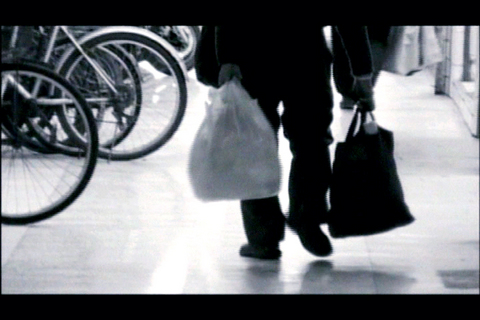In the winter of 2003, a filmmaker named Thomas Joiret came to Taipei to meet his composer friend Pierre Hujoel who has lived in the city on and off for the past five years. A joint film project quickly evolved and a musical documentary on Taiwan entitled Sarabande was completed one year later, garnering an award at Traces de Vies Documentary Film Festival in the French city of Vic-le-Comte. But what the artist duo truly wanted is for Taiwanese audiences to see the film.
Two years after its completion, the film finds its first local screening venue at PS Cafe in the heart of the young and hip East District. Frequented by artist sorts and young hipsters, the intimate, laid-back cafe extends a warm welcome to the documentary about the island's search for identity with a newly equipped projector.
Shot elegantly in black and white, the filmic pas de deux of Joiret's poetic imagery and Hujoel's lyrical music, swings between the buoyant to the dismal. "When looking at the city from MRT trains, Joiret was fascinated at how a festival scene could quickly change to a bleak view, and he wanted to capture such vibes in the film and my music," said the 27-year-old musician who is completing a master's degree in music composition in Belgium while working as a composer in Taiwan.

PHOTO COURTESY OF PIERRE HUJOEL
It's a familiar backdrop in the works of Charlie Chaplin whom the director adores and Sarabande is structured in a manner akin to a silent film where each passage is punctured by verses written in French. With a solid academic background in architecture, the 29-year-old filmmaker creates a surprisingly mature and well-orchestrated work that weaves a series of sketches of locals' daily lives into a personal commentary on the island's political reality.
"Putting art and politics together always has risks. But after seeing the National Taiwan University's (國立台灣大學) archives on KMT's dictatorship in the island, Joiret decided to give it a shot and made the film," said Hujoel, adding that it is an artist's job to create a personal vision with the material, albeit limited, at hand.
To the Belgian duo, the film's raw material is the daily activities, the faces and the gestures of the island's inhabitants that bear imprints of the country's history and its making. "Joiret knew right away the project had to be shot in black and white since to make a proper portrait of the fully-toned city with color film would require years of study. He would go out shooting footage everyday after noon. Sometimes he waited long hours for something he outlined in the storyboard to happen and sometimes little stories he liked just came across his path. He did it for six months and I will say the film uses only one percent of the total footage shot," Hujoel said.
The end result is an intelligent work graced with acute tenderness to the filmed subjects who were unaware of the non-intrusive camera. Audiences see Taiwan through the director's sober lens. The film closes with a little girl in a white dress piling up dropped fruit at a park, building a future to come.
People who attend the opening screenings tonight can also view a photo exhibition about the film and enjoy light refreshments prepared by the 26-year-old store manager Monica Hsieh (謝孟潔), who said the space is now open to anyone with an artistic vision to share.

Desperate dads meet in car parks to exchange packets; exhausted parents slip it into their kids’ drinks; families wait months for prescriptions buy it “off label.” But is it worth the risk? “The first time I gave him a gummy, I thought, ‘Oh my God, have I killed him?’ He just passed out in front of the TV. That never happens.” Jen remembers giving her son, David, six, melatonin to help him sleep. She got them from a friend, a pediatrician who gave them to her own child. “It was sort of hilarious. She had half a tub of gummies,

June 23 to June 29 After capturing the walled city of Hsinchu on June 22, 1895, the Japanese hoped to quickly push south and seize control of Taiwan’s entire west coast — but their advance was stalled for more than a month. Not only did local Hakka fighters continue to cause them headaches, resistance forces even attempted to retake the city three times. “We had planned to occupy Anping (Tainan) and Takao (Kaohsiung) as soon as possible, but ever since we took Hsinchu, nearby bandits proclaiming to be ‘righteous people’ (義民) have been destroying train tracks and electrical cables, and gathering in villages

The wide-screen spectacle of Formula One gets a gleaming, rip-roaring workout in Joseph Kosinski’s F1, a fine-tuned machine of a movie that, in its most riveting racing scenes, approaches a kind of high-speed splendor. Kosinski, who last endeavored to put moviegoers in the seat of a fighter jet in Top Gun: Maverick, has moved to the open cockpits of Formula One with much the same affection, if not outright need, for speed. A lot of the same team is back. Jerry Bruckheimer produces. Ehren Kruger, a co-writer on Maverick, takes sole credit here. Hans Zimmer, a co-composer previously, supplies the thumping

Swooping low over the banks of a Nile River tributary, an aid flight run by retired American military officers released a stream of food-stuffed sacks over a town emptied by fighting in South Sudan, a country wracked by conflict. Last week’s air drop was the latest in a controversial development — private contracting firms led by former US intelligence officers and military veterans delivering aid to some of the world’s deadliest conflict zones, in operations organized with governments that are combatants in the conflicts. The moves are roiling the global aid community, which warns of a more militarized, politicized and profit-seeking trend